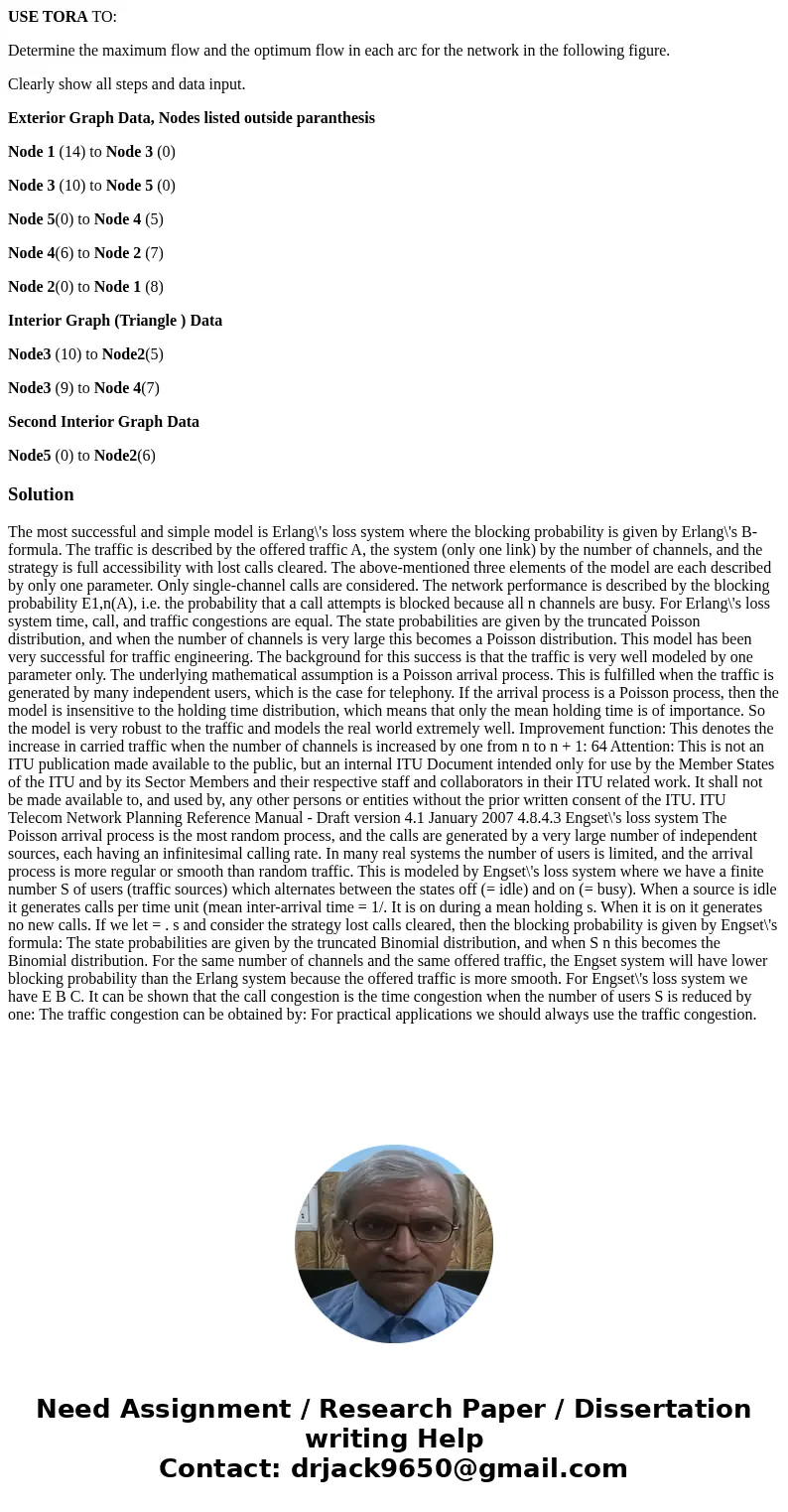USE TORA TO Determine the maximum flow and the optimum flow
USE TORA TO:
Determine the maximum flow and the optimum flow in each arc for the network in the following figure.
Clearly show all steps and data input.
Exterior Graph Data, Nodes listed outside paranthesis
Node 1 (14) to Node 3 (0)
Node 3 (10) to Node 5 (0)
Node 5(0) to Node 4 (5)
Node 4(6) to Node 2 (7)
Node 2(0) to Node 1 (8)
Interior Graph (Triangle ) Data
Node3 (10) to Node2(5)
Node3 (9) to Node 4(7)
Second Interior Graph Data
Node5 (0) to Node2(6)
Solution
The most successful and simple model is Erlang\'s loss system where the blocking probability is given by Erlang\'s B-formula. The traffic is described by the offered traffic A, the system (only one link) by the number of channels, and the strategy is full accessibility with lost calls cleared. The above-mentioned three elements of the model are each described by only one parameter. Only single-channel calls are considered. The network performance is described by the blocking probability E1,n(A), i.e. the probability that a call attempts is blocked because all n channels are busy. For Erlang\'s loss system time, call, and traffic congestions are equal. The state probabilities are given by the truncated Poisson distribution, and when the number of channels is very large this becomes a Poisson distribution. This model has been very successful for traffic engineering. The background for this success is that the traffic is very well modeled by one parameter only. The underlying mathematical assumption is a Poisson arrival process. This is fulfilled when the traffic is generated by many independent users, which is the case for telephony. If the arrival process is a Poisson process, then the model is insensitive to the holding time distribution, which means that only the mean holding time is of importance. So the model is very robust to the traffic and models the real world extremely well. Improvement function: This denotes the increase in carried traffic when the number of channels is increased by one from n to n + 1: 64 Attention: This is not an ITU publication made available to the public, but an internal ITU Document intended only for use by the Member States of the ITU and by its Sector Members and their respective staff and collaborators in their ITU related work. It shall not be made available to, and used by, any other persons or entities without the prior written consent of the ITU. ITU Telecom Network Planning Reference Manual - Draft version 4.1 January 2007 4.8.4.3 Engset\'s loss system The Poisson arrival process is the most random process, and the calls are generated by a very large number of independent sources, each having an infinitesimal calling rate. In many real systems the number of users is limited, and the arrival process is more regular or smooth than random traffic. This is modeled by Engset\'s loss system where we have a finite number S of users (traffic sources) which alternates between the states off (= idle) and on (= busy). When a source is idle it generates calls per time unit (mean inter-arrival time = 1/. It is on during a mean holding s. When it is on it generates no new calls. If we let = . s and consider the strategy lost calls cleared, then the blocking probability is given by Engset\'s formula: The state probabilities are given by the truncated Binomial distribution, and when S n this becomes the Binomial distribution. For the same number of channels and the same offered traffic, the Engset system will have lower blocking probability than the Erlang system because the offered traffic is more smooth. For Engset\'s loss system we have E B C. It can be shown that the call congestion is the time congestion when the number of users S is reduced by one: The traffic congestion can be obtained by: For practical applications we should always use the traffic congestion.

 Homework Sourse
Homework Sourse